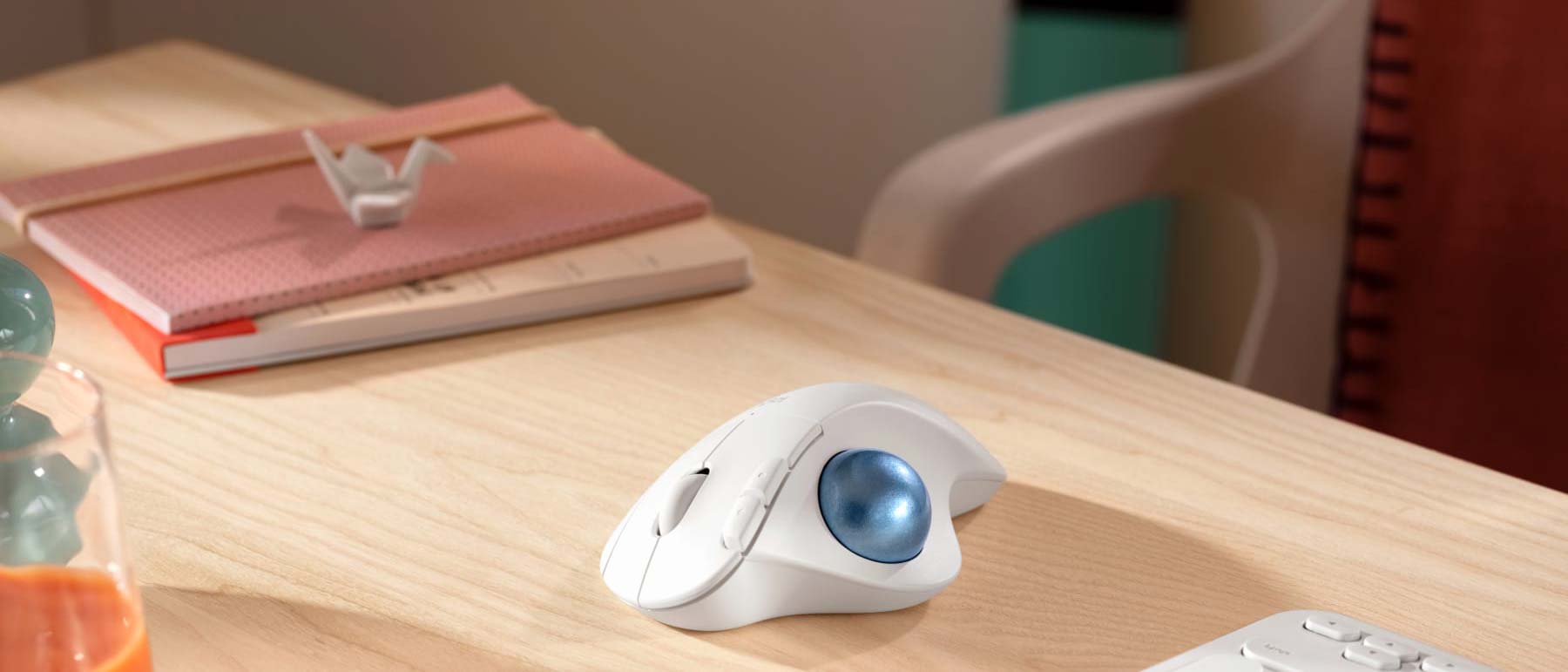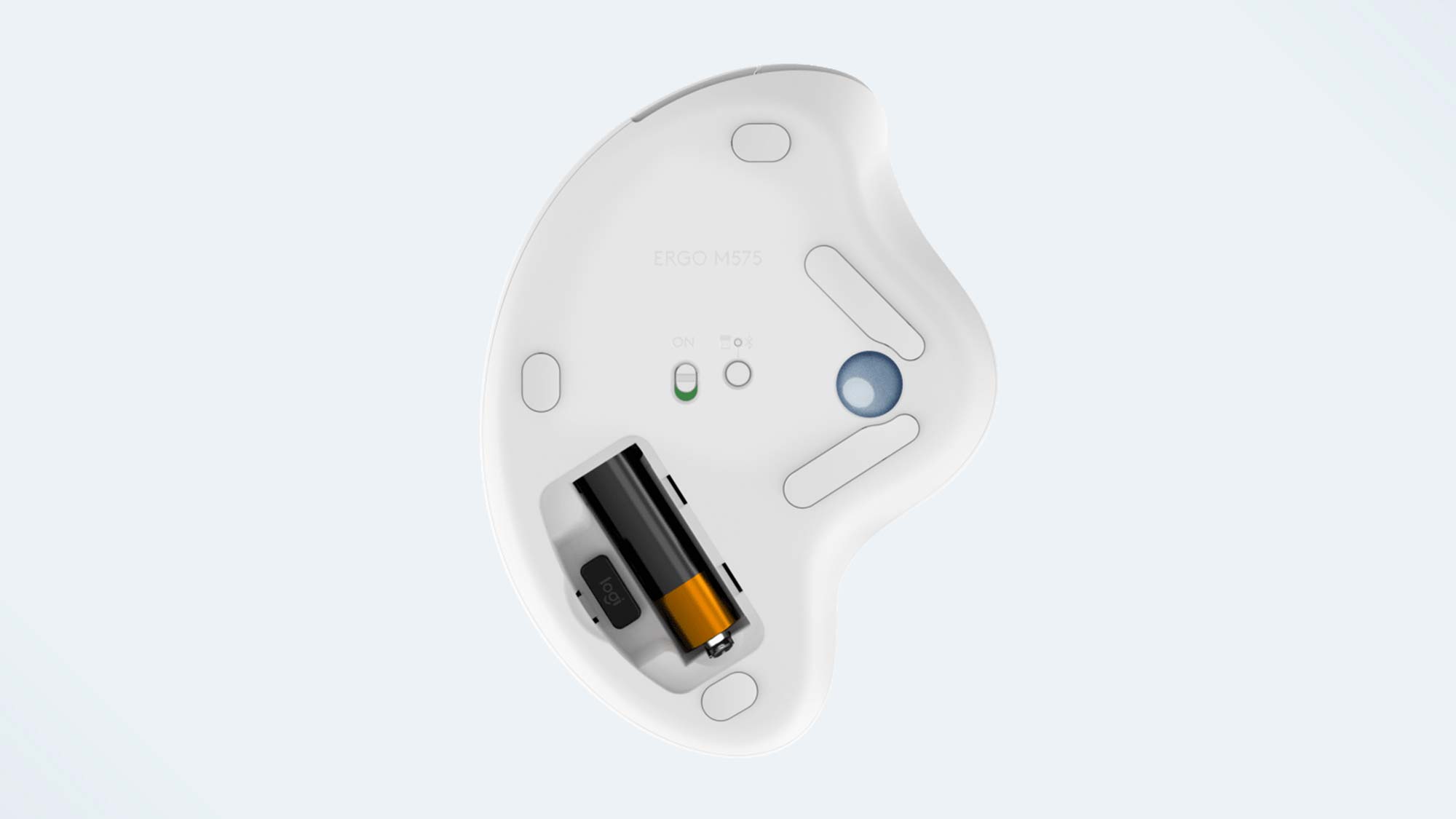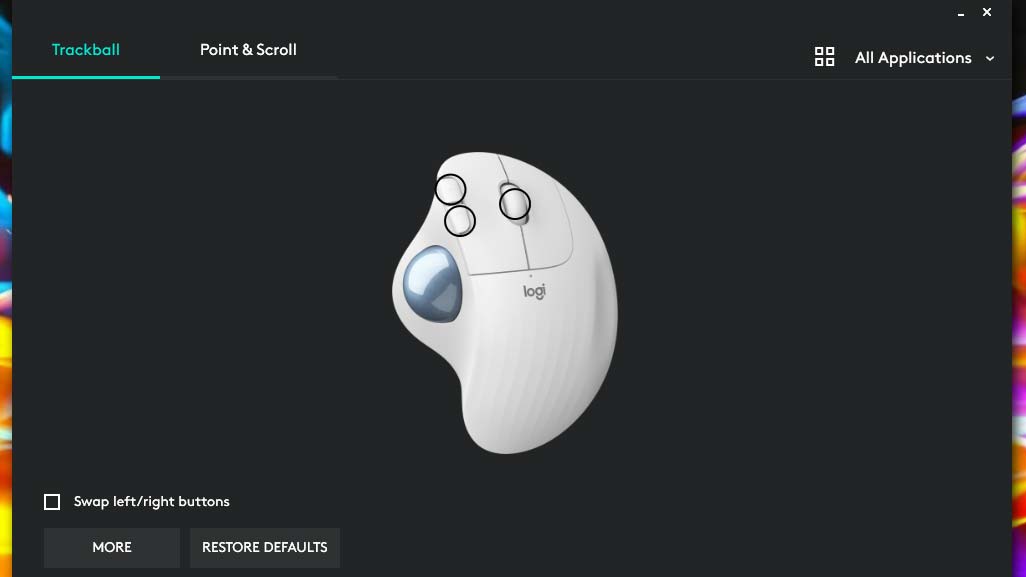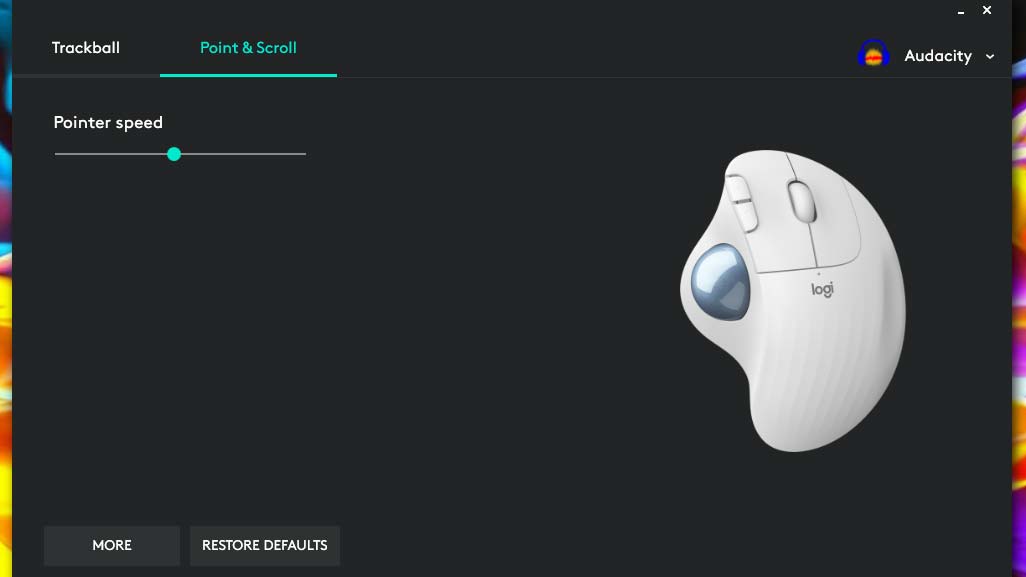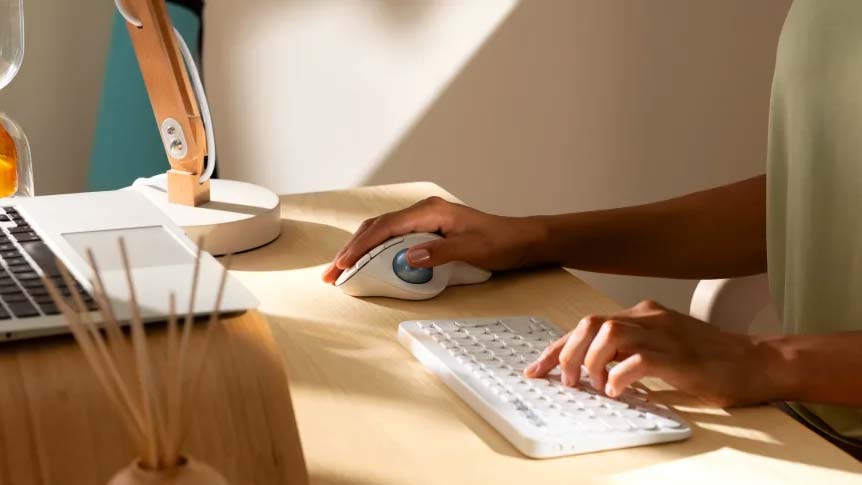Laptop Mag Verdict
The Logitech ERGO M575 is a worthy successor to the well-received M570 trackball. It’s refined for maximum comfort and includes a decent amount of new features, making it ideal for new users and trackball familiars alike.
Pros
- +
Unparalleled hand, wrist and arm comfort
- +
Great battery life
- +
Great performance across the board
- +
Dual connectivity
Cons
- -
Useless for the left-hand gang
- -
No onboard memory
Why you can trust Laptop Mag
When a review unit of the Logitech ERGO M575 landed at my doorstep, part of me recoiled in horror. The other part of me is seemingly deeply petty, and gleefully rubbed their hands together over the idea of finally getting payback for the Marble Mouse’s annoyances from some twenty-two years prior. I can’t lie, I had preconceptions before I’d even so much as opened up the box it arrived in. Nevertheless, I was willing to give the M575 every opportunity to change my mind.
Logitech did not disappoint. The ERGO M575 is a modern revamping of one of Logitech’s earlier offerings, the M570. While staying reasonably faithful to the earlier peripheral’s design, the M575 is slightly larger, with refined curves to further improve on its comfort. Logitech’s Advanced Optical Tracking sensor replaces the previous iteration’s laser sensor, which boosts the maximum sensitivity from 1200DPI to 2000DPI. The M575 also features Bluetooth connectivity in addition to a 2.4GHz wireless connection, and an increased battery life of up to 24 months.
Available in off-white or graphite for Windows, macOS and iPadOS devices, the M575 seems worthy of its $49.99 price tag on paper. But is it worth the shift in operation from laser mouse to trackball? I spent a week relying solely on the M575 for all aspects of my computing to get as good an answer to that question as possible. I hate to show my hand so early on this one, but yes, the Logitech ERGO M575 definitely changed my mind about trackball mice.
Logitech ERGO M575 design
The word ergonomic doesn’t usually inspire much faith in a product’s design. As a general rule in life, I’ve found that what looks good is uncomfortable, and what is comfortable is so ugly it would vomit at its own reflection. Think orthopedic shoes, or somebody wearing a slanket for prime examples.
Yes, at first glance the ERGO M575 does look like somebody has shot YouTube’s popular red hot nickel ball into the side of a perfectly functional mouse. But as unconventional as it appears to anyone unfamiliar with this style of mouse, the blend of swooping curves and rounded edges that make up the body of Logitech’s peripheral grow on you the more you look at it.
One thing partially responsible for this is Logitech’s decision to keep the mouse modest. There’s no RGB and no unnecessary amount of inputs bedazzled across its chassis. There are just two additional programmable inputs, jigsawed into the edge of the left mouse button. This places them within reach of the slightest of index finger movements, without ever becoming a cumbersome intrusion. The single-axis notched mouse wheel is positioned perfectly for quick usage, and delivers subtle, but clear feedback on each scroll.
The star of the show is, of course, the cerulean blue trackball. Its lower positioning retains the natural posturing of your hand and it glides with ease on every gesture. Its optical sensor has an accuracy of up to 2,000DPI, which is fairly accommodating considering that the default setting Logitech decided upon is 400DPI.
Sign up to receive The Snapshot, a free special dispatch from Laptop Mag, in your inbox.
Present on the underside of the device are controls to turn the mouse on/off and a button that switches the device between a 2.4-GHz wireless or Bluetooth connection. There’s also the battery compartment which stores a standard AA battery and doubles as a nifty hide-away for the wireless USB receiver.
Logitech ERGO M575 comfort
The ERGO M575 is comfortably pitched at an angle between that of a vertical mouse and the traditional mouse frame. I was impressed by how the curvature accurately mimicked my hand at a resting position. Cupping the device in my palm felt entirely natural, with the only adjustments to my posture being a slight incline of the wrist. My thumb naturally gravitated to the center of the side-mounted trackball in this position, giving me a real sense of control when in use.
The bulkier size of the M575, along with its 5.1-ounce (145 gram) weight, isn’t much of an issue when you take into account that it doesn’t require any traveling space. With all cursor movement handled through the trackball, the larger profile of the M575 requires less space than a traditional mouse would. Across the bottom of the mouse, five rubber grips do their best to keep the device stationary. However, on smooth surfaces these can, at times, do very little to prevent minor traveling.
The only concern I have about the M575 is its asymmetrical design. While it achieves what it was designed for — offering the user a fantastic level of comfort and support — left-handed users who prefer to stay true to their hand’s natural inclination (and don’t have the pinky dexterity of a gymnast) have no hope of coming to grips with this peripheral. Literally.
Other than that, I can’t really fault the Ergo M575 on its design. It may be the most comfortable mouse that I’ve ever had the opportunity to use. The longer I use it, the more I appreciate both its style and simplicity. I put this mouse through some pretty heavy usage across a number of days, and at no point did my wrist, thumb or arm feel anything close to fatigue. It’s a lesson in getting the job done right without having to cover up your shortcomings with garish RGB or fanciful gimmicks.
Logitech ERGO M575 features
Three of the M575’s five available buttons are programmable. Those include the two additional buttons alongside the left-mouse button and the scroll wheel click. You can easily configure the buttons within Logitech Options, Logitech's own peripheral configuration software, which is available on both Windows and macOS.
Within the app, you can set up program-specific profiles with tailored commands for each button. This could mean assigning copy and paste to buttons for quick access in Microsoft Word or setting up one-click access to shortcut keys for video-editing software. The only feature missing is the ability to create your own macros for more advanced instructions. However, there is still a sizable array of commands and key combinations available to suit most needs.
One of the more useful operations you can link to your inputs is the ability to hold down a button and use the trackball to set your pointer speed, or simply click to switch between two presets. Fine tuning the sensitivity of the trackball on the fly without needing to switch programs can be great for a quick boost in precision while working with video and audio files. However, there are no DPI numbers displayed while doing this, so you’re left to guess where you’re at sometimes. Even within the Logitech Options app, your DPI is adjusted with one unlabelled slider. It would’ve been nice to know some of the figures behind my choices, but I still got the results I wanted regardless.
It’s worth pointing out that, while setting up profiles is great, the lack of any onboard memory within the M575 means you’ll need to download the Logitech Options app onto any other device you wish to use it with in order to carry over those configurations. It’s by no means a deal breaker, but it could become a little inconvenient if you do a lot of machine hopping.
Another interesting feature of the ERGO M575 is dual connectivity. The M575 can wirelessly connect to your computer via the included USB receiver, or by Bluetooth LE if no USB port is available. Bluetooth’s notoriety for draining power is fairly well known, but Bluetooth LE is a low energy standard that vastly reduces the power consumption of your peripherals by remaining in sleep mode until woken by a command.
With just one AA battery, the M575 can remain powered with Bluetooth LE for up to 20 months. While impressive, connecting via the USB receiver still remains the ideal, as Logitech estimates that one AA battery in this mode can last up to 24 months.
Logitech ERGO M575 performance
After using the ERGO M575 in all aspects of my computing life for the last week, I can safely say that it has shattered my preconceptions about trackball mice. Logitech’s modern offering is a far cry from the Marble Mouse that haunted my early gaming days.
It wasn’t all smooth sailing, however. There is an adjustment period to be expected when making the switch to a trackball. In my first few hours with the M575, I would find myself occasionally attempting to push it around the desk, And controlling the cursor through the trackball was done with the grace of a newborn giraffe being catapulted across a frozen lake.
You’ll also have to spend some time adjusting the cursor speed in both your operating system and Logitech Options to find the right balance for regular use. If you’re a Windows user, I’d also recommend disabling ‘Enhance pointer precision’ within the pointer options tab of your mouse settings. Disabling this option removes any additional mouse acceleration applied to your movements, making the trackball feel much more precise.
Once you’ve personalized your responsiveness, you’ll find the movement of the cursor becomes much more intuitive. You won’t be topping leaderboards in Call of Duty any time soon though. This isn’t exactly a gaming mouse after all. But you will find that movements — both subtle and large — become much easier to predict and accurately pinpoint. It’s surprisingly intuitive actually. Excuse the pun, but once you get the ball rolling on the M575, there’s very little getting in the way of adaptation thanks to its simplicity and comfort. After only a day of use, I was handling the M575 almost as accurately as I would with my regular mouse.
It was all shaping up to be a clean sweep for the ERGO M575. Until, that is, the thought about it not being a gaming mouse popped back into my head. I didn’t want to sabotage the M575 at the last hurdle, but morbid curiosity did keep me wondering.
Before I knew it, I was dropping into a Counter Strike lobby full of angry teenagers who were entirely unsympathetic to my ongoing M575 experiment. I spent the first few rounds being mocked and derided for my awful aim and general ineptitude. But remembering I had programmed one of the buttons to finely adjust the cursor sensitivity allowed me to slowly ‘tune-in’ to the sweet spot for my aim.
While I realized my dreams of spinning the trackball so fast that I could pull off 900-degree no-scopes and crowning myself the Tony Hawk of Counter Strike had faded, I was no longer the worst person in the lobby.
My thumb almost never needed to leave the surface of the trackball, meaning I had continuous control over my aim. I never had to lift the mouse to recenter it, which would only cost valuable milliseconds in combat. And it would seem that all these years of console gaming and speed-texting had developed a keen sense of precision with my thumbs that I wasn’t fully appreciative of until this moment.
However, it may not have improved my middling gaming capabilities, and an optical mouse is, admittedly, reliably more accurate. Whether that’s due to familiarity or not, I am unsure. But I was pleasantly surprised at just how easy it was to adjust to the trackball. Not to mention performing at a recognizable level so quickly.
Bottom line
Considering my past trackball mice issues, the Logitech ERGO M575 had an uphill battle on its hands to impress me. However, over the last week, my anti-trackball bias has been so thoroughly obliterated that I actively want to keep using it. I’ve worked for longer stretches of time without a hint of fatigue and, more than that, I do it comfortably.
It may not be the flashiest peripheral on the market. Frankly, the off-white model can look like old-tech at first glance. But there is style in both its curvy exterior and simple layout. The trackball performs wonderfully across a range of exercises, whether I edited video, working on projects in Unity, or gaming. I felt that if given enough time to adjust to the trackball in each scenario, it would reliably pay off each time.
There’s so much the M575 does right that finding issues with the peripheral almost felt like nitpicking. Yes, if you like to use left-handed peripherals, you’re out of luck. And yes, the lack of onboard memory could become tedious for some. But the overall experience I’ve had with this mouse has been otherwise flawless.

Rael Hornby, potentially influenced by far too many LucasArts titles at an early age, once thought he’d grow up to be a mighty pirate. However, after several interventions with close friends and family members, you’re now much more likely to see his name attached to the bylines of tech articles. While not maintaining a double life as an aspiring writer by day and indie game dev by night, you’ll find him sat in a corner somewhere muttering to himself about microtransactions or hunting down promising indie games on Twitter.
